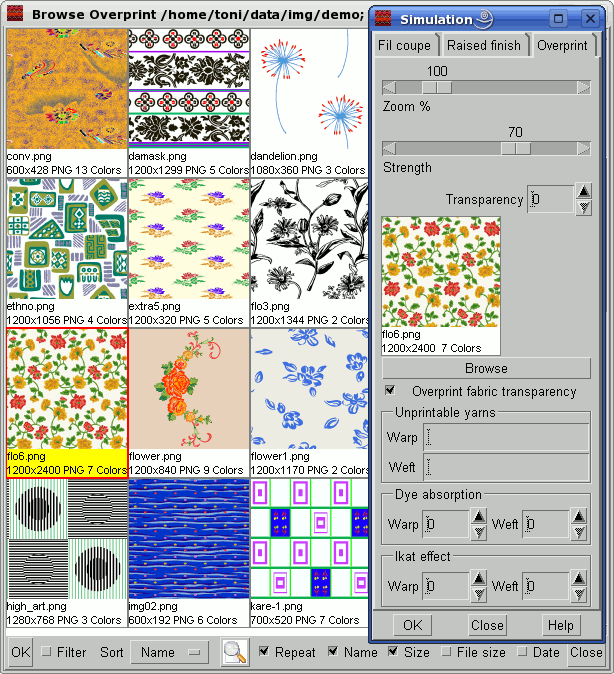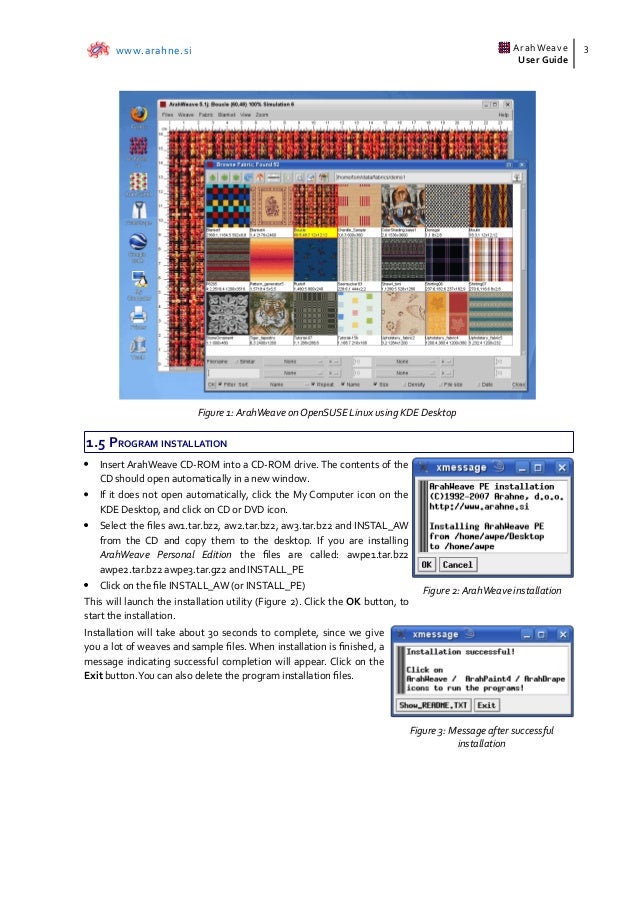Jacquard Design with ArahWeave PE
ArahWeave Design realistic dobby and jacquard woven fabrics ready for production, and weave them with our smart loom support. Integrated CAD/CAM software solution for textile industries, weaving mills, converters, design studios and schools.
NOTE: Beljen Mills is no longer in operation.
- I have been designing for the Beljen Mills Jacquard power loom using ArahWeave PE, information contained in The Woven Pixel and custom software that produces power loom design files. ArahWeave PE's commercial quality textile design features makes it possible for me to get quicker, more reliable results than if I created fabric designs in Adobe.
- D esign fabric with real fabric technical data such as thread pattern, weave structure, density, yarn composition, yarn color and much more. Interactive editing allows you to see the modification on the fabric simulation immediately. Save the fabric image or print it in real size to reduce you sampling overhead.
- Twill weave designing by arahweave software.Designed by;Md siful Islam Bulbulintake: 9thsection: 1Department of textile Engineering Bangla.
This article describes how to design for a Jacquard power loom using ArahWeave PE (Personal Edition). It shows the steps needed to produce a fabric design that has a good chance of weaving as expected. This article does not go into the details of how to use ArahWeave PE. They are very well covered in Arahne's tutorials and the ArahWeave user manual.
ArahWeave PE is “intended for owners of electronic jacquard handlooms, and design studios without the need for driving the production machinery.” It offers many of the features you would get with the full ArahWeave Jacquard Edition. However, it does not provide support for saving designs for power looms or other features mainly of interest to textile mills.
I have been designing for the Beljen Mills Jacquard power loom using ArahWeave PE, information contained in The Woven Pixel and custom software that produces power loom design files. ArahWeave PE's commercial quality textile design features makes it possible for me to get quicker, more reliable results than if I created fabric designs in Adobe PhotoShop.
Background
In 2003, I got a TC-1 loom and needed a way to produce designs for it. I expected to design fabrics using the PhotoShop techniques taught by Vibeke Vestby of Digital Weaving Norway. I also downloaded a demo version of ArahWeave intending to use it to design weave structures for use in fabric designs. Once I experienced ArahWeave PE’s power and ease of use however, I decided to do all my designing in ArahWeave PE and purchased a copy. This was the base version of ArahWeave PE that supports designs up to a maximum size of 2048 ends x 2048 picks.
After I began designing for the Beljen Mills loom, I upgraded to the version of ArahWeave PE that supports a 4096 x 4096 maximum design size. That made it much easier to produce designs for this large loom. I now use a copy of ArahWeave PE that supports design sizes up to 16,384 x 16,384. This allows me to produce a design for the full width of the Beljen Mills Jacquard loom as a single ArahWeave PE fabric design.
Arahweave software, free download
Preparation
Preparation really starts with creating a library of weaves designed for the Beljen Mills loom. My weave library contains weaves with traditional warp tapestry faces as well as variations where the face of the cloth shows longer warp floats. Using ArahWeave PE, it was straightforward to produce weaves for all possible combinations of 8 different warp colors having up to 3 visible face warps.
With a weave library in place, the next step is to create a new fabric design in ArahWeave PE and configure it to match the Beljen Mills loom's set up. This step enables ArahWeave PE to provide realistic weave simulations. Because I send my designs to another state to be woven, I rely heavily on ArahWeave PE’s fabric simulations in making design decisions.
Good fabric simulation depends on matching the yarn colors, yarn structures and weave density as closely as possible to what they will be in the woven fabric. Color matching can be especially difficult as computer screens are not capable of displaying all yarn colors.
Configuring Colors
ArahWeave PE comes with several databases of colors. You can also save new color databases containing colors selected from other color databases. The next image shows the ArahWeave PE dialog for loading a color database. Note all images can be enlarged by double clicking on them.
I work with a small set of PANTONE colors that approximate the colors in the Beljen Mills tapestry loom's warp and available wefts. The following image shows the Beljen Mills warp colors across the top row in the order they actually occur in the warp. The leftmost 4 colors in the second row correspond to the available figuring weft colors. Any of the warp yarns can be used as a binder weft.
Configuring Warp and Weft Patterns
Configuring the warp and weft pattern for the Beljen Mills loom is simple. The loom has a rotation of eight warps. All my weaves use two figuring wefts and one binder weft. The next image shows these patterns entered in the fabric design.
Configuring Yarns
Arahweave PE supports designing yarns that match those used to weave the fabric. In the case of the Beljen Mills loom, the warp is made up of 50/2 cotton and the figuring wefts are 6/1 cotton. The next image shows the yarns assigned to each warp and weft that will be used in the fabric.
Arahweave Software

Configuring Density
Although I request my designs be woven at 80 picks per inch as recommended in The Woven Pixel, the fabric relaxes once off the loom. I design for the off loom weave density. Experience has shown this will be about 87 picks per inch and 172 ends per inch given the weaves I use. The next image shows how the fabric's weaving density is set in ArahWeave PE.
All these configurations need only to be entered once. Once you create your first design for the Beljen Mills loom, you can start work on new designs by copying a previous design.
Designing the Fabric
The design image used in this article is the first one I wove that used entire width of the Beljen Mills loom. The original design image was square with 1520 pixels on each side. These dimensions needed to be adjusted to prevent the image in the fabric from being distorted.
The fabric's weaving density gives a face density of 29 picks per inch (87 / 3) and 21.5 ends per inch (172 / 8). To compensate for this difference, I adjusted the height of my initial design image to be 35% taller (29 / 22.5 = 1.35). After increasing its height by 35%, the design image was 2052 pixels high.
The original design image contained 10 shades of grey. I added a red border around the image to provide material for hemming the fabric. That meant eleven weave assignments were needed before ArahWeave PE could convert them into the fabric's weave structure.
Weave Assignments Using Jacquard Conversion
When design images are loaded into ArahWeave PE's Jacquard conversion dialog, their colors initially sort by percentage of use with the most prevalent colors leftmost. My images tend to have fine shade gradations. I like to to see their colors sorted by greyscale. This makes it easier to assign weaves to them that match their relative shade differences.
The next image shows the Jacquard conversion dialog after the design image colors have been sorted by greyscale and initial weave assignments made.

A downside of working with the design image colors sorted by greyscale is the color ordering is not saved when the fabric is saved. It is a good idea to save the weave assignments you make using the Conversion/Save conversion command. That way you can bring up the Jacquard conversion dialog, sort colors by greyscale, load the saved conversion and pick up refining your weave assignments where you left off.
I like to visually browse the the available weaves when making weave assignments. ArahWeave PE supports browsing weaves with and without weave simulation turned on. This image shows a weave browser displaying weave structures without simulation.
The next image shows the same weave browser after weave simulation has been activated. The weaves are simulated using the colors, yarns and density you have set for the fabric.
ArahWeave PE makes it easy to check which portions of a design will be effected by each weave assignment. Clicking on a color box causes the areas where it occurs in the design image to be briefly highlighted. The next image shows the design image highlighted after clicking on the fourth color from the left.
I wanted to select weaves that would darken the upper right area of the fabric relative to the design image. This highlight feature was very helpful in doing so.
Once weaves have been assigned to all the colors, it is time to generate the fabric's weave structure. Before doing this, set the Warp multiplication factor to x8 and the Weft multiplication factor to x3 to match the number of ends and picks represented by each design image pixel. Finally, clicking OK causes ArahWeave PE to convert the design image and weave assignments into the fabric's weave structure.
This image shows ArahWeave PE's simulation of the entire six foot by six foot fabric design much reduced in size.
The next image shows a detail from the fabric simulation at real scale. You can see part of the hem section of the fabric at the top and left of the image.
Checking and fixing floats

It is important to check your fabric design for long warp and weft floats that can cause problems in the woven fabric. ArahWeave PE's Float dialog displays charts of the tallies of warp and weft floats of varying lengths that appear on the front and the back of the fabric.
This image shows this fabric design's float analysis immediately after the Jacquard conversion.
Because this fabric design is not intended for hard use, I chose to have ArahWeave PE automatically make corrections so that no floats would be longer than 30 picks or ends. The next image shows the feedback ArahWeave PE gave after correcting the floats as requested.
This image shows the float analysis after floats were corrected.

Exporting the Card Image
Once the fabric design is complete, it can be exported as a card image and converted into a Staubli JC5 design. Selvedges and technical ends are added to the fabric design in ArahWeave PE's Save cards for production dialog as shown in this image.
Arahweave Software
The next image shows a preview of the right edge of the card image that will be exported.
Producing the Staubli JC5 Design File
Arahweave software, free download
Because ArahWeave PE does not support saving design files for power looms, the fabric's card image is saved as a GIF image file. The GIF file is then translated into a Staubli JC5 design file by Gif2BeljenJC5. This Staubli JC5 design file is then emailed to Beljen Mills to be woven. This last image shows Gif2BeljenJC5 after it has completed writing out the Staubli JC5 design file.
An photograph of the fabric that was woven from this design can be seen in my gallery.
